This is Part 2 from 125 Building Blocks for Your Bakery Business
Bakery Selling Options
This chapter examines the various modes of sale available to bakeries, including retail, farmer’s markets, wholesale, and mail order.
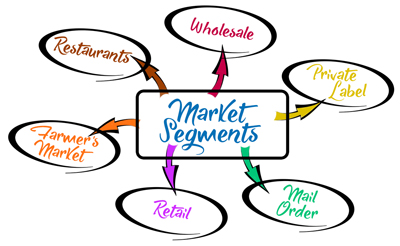
In the bakery industry, there are many different kinds of market segments. Successful bakeries tackle as many areas of the market as they can. The more areas you tackle, the more revenues you stand to collect. The more you diversify, the more financially secure your business becomes.
The Retail Bakery Market
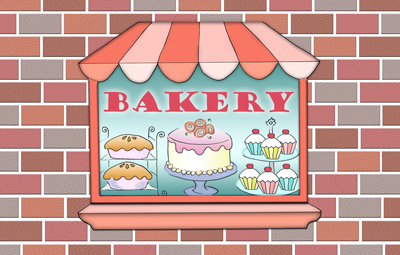
When we hear the word “bakery,” we think of the classic brick & mortar store with glass cases lined with fresh baked goodies. This is the dream for many bakers. However, it requires a significant amount of work to operate a retail bakery. It also requires a large amount of upfront financial capital to fund equipment, ingredients, and supplies, as well as ongoing overhead costs like rent, utilities, and maintenance. If you decide to go this route, it would be wise to start your business at home (if cottage law happens to exists in your state) or as a part-time tenant in a shared commercial kitchen establishment. This will give you time to test out your business concept on the market and build momentum and clientele before you make a big financial investment. Read more about bakery locations << here.
The advantage to owning a retail storefront is that it lends a kind of legitimacy to a bakery brand that makes other avenues of sale easier to access, such as wholesale accounts. The disadvantage to owning a retail storefront is that it is a permanent commitment. You will be required to honor a set schedule. You will be required to have goods on hand at all times. You will need to be diligent, committed, multi-tasking, and customer service-oriented.
Farmer’s Market Bakery Option
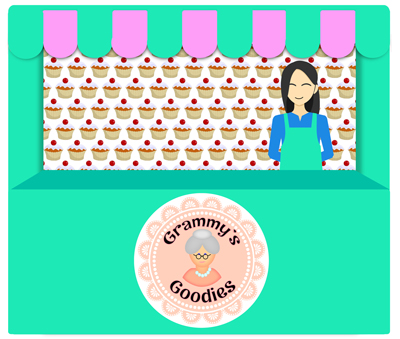
Local farmer’s markets are an excellent venue for selling treats, both to customers looking to stock up on groceries for the week and to those seeking a quick bite to eat.
Daily Farmer’s Market
Depending on where you live, the farmer’s market scene could conceivably act as your storefront or perhaps your initial storefront as you build an active clientele. The advantage to this system is that it comes complete with built-in foot traffic. In San Diego, California, where I used to live, farmer’s markets are held year round. On any given day, in any part of the city and its surrounding suburbs, multiple farmer’s markets are held. Many food vendors here make their living exclusively within the farmer’s market circuit, selling their goods in a different location each day. Some use the farmer’s market scene to boost sales for an existing wholesale, retail, or cottage business.
Renting a booth at a farmer’s market involves obtaining a food permit plus a permit with your city/town to occupy a booth. Depending on the popularity of the market, you may need to join a wait list before earning a spot. Typically, you must provide the tent, tables, and all wares for your booth, so there is an upfront investment involved. However, the investment is far less than the cost of running a retail establishment.
If you participate in a daily rotation of markets throughout the week, you will earn the most return on your investment. However, if being present daily at the farmer’s market in addition to tending to your production work is too much, you may need to hire employees to run your booth. Keep in mind that people who shop at farmer’s markets do so because they enjoy the experience of meeting the individuals who grow/cook/bake their food. Therefore, it is recommended that your employees are sales-oriented, enthusiastic, and knowledgeable of your product line. They should be able to answer any question a customer might pose.
Weekly Farmer’s Market
If your city or town only has one farmer’s market per week, then it probably won’t have the force to act as your primary mode of sales but rather as an avenue where you sell products and gain exposure for your brand. With a once-per-week schedule, be sure that the products you produce for the market have a long enough shelf life so leftovers can be stored and resold before expiration. Macaroons and shortbread cookies are good examples of products with a long shelf life. Cakes and brownies are good examples of products that can tolerate freezing. Fresh pastries like croissant and danish are more time sensitive and challenging for this type of market. Without other avenues of sale for you to unload your leftovers, you may run into problems with spoilage loss.
Weather is also a factor to consider. Farmer’s markets are typically held outdoors. Depending on your local climate, you may be dealing with hot summers or humid air. Temperature and humidity have a deleterious effect on baked goods. Be sure you have the equipment to handle it.
Selling Wholesale Baked Goods to Other Retailers

If you are savvy with marketing, you may consider negotiating the direct sale of your product to coffee shops, boutique eateries, and small grocery or specialty stores. This involves identifying the person in charge of purchasing, cold calling, dropping in, handing out samples paired with marketing materials, then diligently following up with that buyer. Existing shops have the potential to offer you a steady stream of business and camaraderie. Some specialty grocers have such good selling power that they may buy at the same rate and volume as a distributor. This is a great type of business relationship to have.
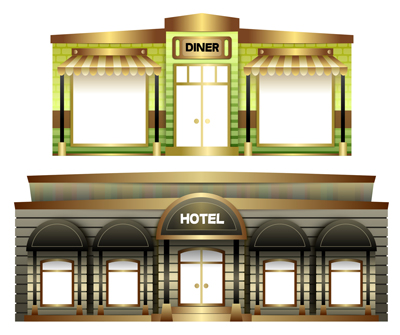
A good rule of thumb is to offer restaurants and hotels the option for direct purchase from you *if and only if* they agree to purchase consistently above a certain volume. In that case, you should offer them a price break for doing so. For smaller orders, it makes more sense to refer their business to your distributor. Typically, distributors don’t allow crossover to occur (meaning sometimes you sell directly to a customer, sometimes you sell to that same customer via the distributor) so you will have to choose.
Selling Wholesale Baked Goods to Event Venues

Another type of venue that sells outsourced desserts is the restaurants within concert halls and stadiums. Again, you will have to identify the name of the buyer and develop a relationship so you can pitch your ideas. Ideally you want to sell items from your existing product lines but sometimes clinching this type of sale is a matter of catering to the needs of the establishment by designing a product fit for their clientele.
For example, as a pastry chef working in Boston, I designed individual Boston Cream Pie desserts with baseball stitching on top, which the salesperson sold to Fenway Park, the baseball stadium that is home to the Red Sox. Luckily, Fenway did not require an exclusive deal from us so we ended up selling that product widely throughout baseball season. It turned out to be a big hit.
You may also consider selling your desserts at a booth at a special event such as an arts or cultural festival. In terms of logistics, this type of event runs much like a farmer’s market except it’s a onetime deal.
Selling Wholesale to Distributors
Behind the scenes, the silent warrior of many successful bakery operations is a wholesale operation. Wholesale involves selling your product in bulk to high-volume retailers and/or commercial distributors. Wholesale business is easier than retail because it consolidates every aspect of operations including sales, customer service, production, and pick-up/delivery.
Five Advantages to Wholesale Baking
Advantage #1 Reliability
Wholesale accounts tend to be more reliable, since they service the widest possible segment of the market. In the slow seasons between holidays or when retail bakery foot traffic lags, wholesale accounts tend to keep chugging along.
Advantage #2 Experienced Buyers
Instead of dealing individually with each and every consumer, catering to all their differing wants and needs, you interact only with wholesale account buyers. Buyers act as the liaison between you and their consumer base. They are experienced in understanding and anticipating the average consumer’s wants and needs.
Advantage #3 Turnover
Higher volume of production equates to a higher rate of turnover, meaning you move more product out the door every week. When that is the case, you can afford to increase the amount of inventory you keep on hand, knowing you are more likely to sell it. In that case, your product will be fresher and more readily available for other customers.
Advantage #4 Efficiency
As long as you operate with production efficiency, it is a mathematical certainty that as your production volume goes up, your time spent on each unit goes down. In other words, the more goods you make, the faster you get at making those goods. The faster you get at making goods, the lower your labor costs become.
Advantage #5 Purchasing Power
As you increase production volume, your purchasing volume will also increase. The more you purchase, the more leverage you gain as a buyer of ingredients and packaging. As your cost of ingredients goes down due to price breaks, you have the advantage of being able to extend some or all of the savings to your clients, thus undercutting your peers. Alternatively, you can retain some or all of the savings, thus increasing your profit margin.
Working With Distributors
The primary type of wholesale customer is the distributor. Distributors are third parties that amass and warehouse a bulk volume of products, which they resell in bulk to local businesses. Essentially, distributors act as intermediaries between various different kinds of food businesses, offering many conveniences in exchange for a small profit off each sale.
Wholesale bakeries tend to do the majority of their business through distributors. Since distributors are both buyers of goods and sellers of goods, in some cases, you might be both the customer and the manufacturer in a mutually beneficial relationship with a distributor.
There are many different types of distributors. Some specialize in dairy. Others specialize in ingredients & packaging. Others specialize in ready-made foods. As a bakery, you should seek to sell your products in bulk to the type of distributor that specializes in bakery products and ready-made desserts.
The benefit of selling your products to a local distributor is that they handle marketing and distribution to smaller channels, which means they have the capacity to broaden your customer base. Every one of their customers automatically becomes your customer as well. As a manufacturer, this immensely simplifies your marketing efforts.
In exchange, you will be expected to cut the distributor a discount of approximately 30% off your list price for all products so that they can cover their expenses, turn a small profit, and still sell your products at a competitive price. Part of this percentage goes to their marketing efforts, housing the products, and the freight cost of delivering your product to their customers.
How to Sell Private Label
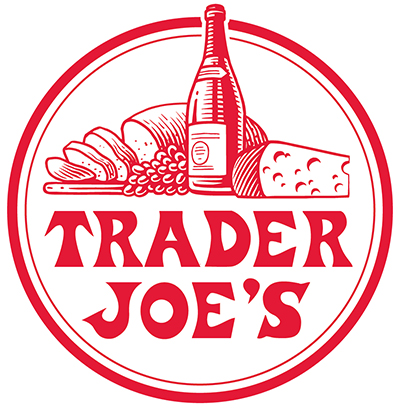
Private Label is the term for the kind of sales exchange in which a manufacturer sells a product without any brand name recognition. On the opposite end, the retailer or distributor who buys from your bakery places their own label on the product (or requires that you do so under their brand name) and re-sells it as if it were their own. This type of retailer tends to be one with strong brand name recognition and built-in sales capacity. They seek bakery manufacturers that can help fill their shelves with product options. If you have the production capacity to service a large company like that, combining forces with them has the potential to be a win-win.
Within the U.S., a good example of a company that buys private label products and resells them under their own brand name is Trader Joe’s. Almost everything Trader Joe’s sells is private label, including their baked goods.
My Private Label Experience: Trader Joe’s
As a pastry chef, I manufactured two private label dessert products for Trader Joe’s. One was a tart tatin and the other was a chocolate almond fudge tart. Designing the products, including the size, the taste, and the packaging was a rigorous back-and-forth process between the buyer and the company where I was employed. Translating those inventions into a high volume production line was even more challenging.
As we “rolled out” the products, i.e. introduced them to market, we began filling large orders. I hired new staff in order to meet the sudden demand. We purchased equipment that helped quadruple our efficiency. After working on the same product over and over, the staff became incredibly fast at doing tasks such as crimping the puff pastry crust and fanning out apple slices.
Six days per week, we shipped our products in bulk under the Trader Jacques name to the Trader Joe’s warehouse. We dropped our products off at one single loading dock while Trader Joe’s took care of warehousing and distributing the desserts to each individual store. Our efforts were all done without any brand name recognition at all. Additionally, we were bound by an exclusivity contract. However, the business more than tripled our annual sales.
Selling Exclusive Products

An exclusivity contract, also referred to as an “exclusive,” is a kind of bargaining chip that big companies use when negotiating sizeable deals. It means that as the manufacturer, you agree not to sell a product in an identical form to any other customer. Depending on what makes the product unique, the exclusivity clause may encompass the product concept, its size/weight, its name, its packaging, or any combination of those characteristics.
As the manufacturer, this is not the kind of agreement you ever want to offer up freely since ideally you want to be able to retain your ability to sell every product to all of your customers. It’s probably also not something to which you want to agree if you already have an existing customer base for that same product in that same iteration.
However, this type of deal is something that may be asked of you when negotiating the sale of a new product with a large company. The reason that company benefits from an exclusive deal is twofold:
1. They can promise their customers unique products that can’t be found elsewhere.
2. They can eliminate the potential for competition.
In the case of the Trader Joe’s deal that I was involved in, because the products were conceived in part by their buyer, we were obligated to accommodate her when she asked for an exclusive deal. And we were happy to oblige because two spots on the shelves of an entire region’s worth of Trader Joe’s stores was a tremendous opportunity. We honored the agreement.
However, it didn’t stop me from inventing as many spin-off products as I could come up with in order to take advantage of the purchasing deals we were getting on the ingredients like apples and almonds. I took the chocolate almond tart recipe and turned it into a brownie bar, which we renamed and sold widely to our other wholesale customers. I used the apple slices to create apple crumbles, cakes and pies for the catering and pastry arms of the business. It was a fun game coming up with clever alternatives without violating our contract.
Selling Directly to National Retailers
National distribution to chain stores is the ultimate form of wholesale business. It involves selling products by the truckload. Products get packaged in cases, which get stacked on pallets, which get shrink-wrapped and moved into trucks via pallet jacks. National distribution is the end goal for the ambitious wholesale baker. It is the type of deal that may arise after years of practice, experience, and forging relationships with buyers.
My Experience with National Distribution: Costco

I once worked as the Director of Product Development at a wholesale baking factory that sold products to Costco stores nationwide. Costco is a smart business model that offers its shoppers a curious kind of hybrid adventure that falls in between the retail and wholesale shopping experiences. On the one hand, they provide all the conveniences of a retail establishment, allowing customers to enter their stores and browse their merchandise. On the other hand, they provide the advantages of a wholesale establishment by selling bulk products at low costs. They save on their own merchandising costs by setting up a wholesale type of environment in which products are stacked on pallets, still in their original boxes, with no frills.
Costco prides itself on offering their customers a “treasure hunt” style journey. As the customer, you have to hunt the isles to see what’s there. You never know what you are going to find in any given isle or store. Especially when it comes to baked goods, from region to region, the merchandise varies. The merchandise options also change without notice. Costco sells only a select number of products, all at deep discounts. They re-sell every item at a maximum markup of 14%, which is extremely low compared to most retail stores, where merchandise sells at anywhere between a 50–200% markup.
Costco stores are segmented into regions. Each region has a different buyer representing it. The buyers compete for who can find the cheapest, most clever products to sell. The buyers are extremely in-tune with market preferences. They are highly likely to suggest product ideas to the manufacturers.
My employer hired a broker to pitch our products to Costco buyers. That broker had an existing relationship with Costco , which earned him direct access to the Costco offices. He represented other bakeries in our area too, so he could condense a number of sales pitches into each meeting with the buyer. He earned a 5% commission on all of our sales.
My employer had two cakes that had taken up long-term residence in Costco stores nationwide. Those items had permanent slots on Costco ’s shelves because their sales numbers were above a certain threshold, meaning they had a very high and consistent rate of sales. At any given time, we also had 1-2 other SKUs (items) in our local region or beyond. These were the “treasure hunt” type items that had a limited run time, such as holiday cakes.
New items were always tested in a limited number of stores before being introduced into the full region. If an item sold well throughout a region, it had the potential to earn spots in other regions as well. We churned out a new list of ideas every single quarter to pitch to the Costco buyers.
Three things to note about Costco
1. They do not pay their manufacturers upfront.
2. The manufacturer covers the cost of returns.
3. The manufacturer covers the cost of demos.
Costco has an extremely forgiving policy when it comes to returns and exchanges. For customers, this is a great perk. For manufacturers, it is a great pain since the expense of returns kicks back to you. That means if someone returns a cake that they bought in a Costco store, no matter what their reason may be, Costco automatically refunds the customer. Each Costco store tallies its own returns/exchanges/damaged products and deducts them from the total number of units on your invoice. Only after that has been calculated do they pay you the difference.
When it comes to baked goods, all returns and exchanges count as a loss since food cannot be re-sold. In addition to returns and exchanges, there are other reasons why Costco might deduct units from an invoice. The product might have expired before they had a chance to sell it. The packaging might have gotten dented from mishandling on the sales floor, either by customers or employees. Costco is not required to provide explanations for this sort of thing so there is no way of knowing what happened. Part of the deal when doing business with a warehouse like Costco is excepting their return policy. Anyone who enters this arena should be prepared and willing to cope with it.
Another expense that you will have to work into your product costs is the demos. Costco gives out free samples to its customers. It’s another one of the perks of the Costco shopping experience that keeps their customers coming back for more. However, Costco doesn’t pay for the free food. When you put a product in their stores, you are required to fund a certain amount of free sample days.
A good rule of thumb when selling to Costco is to work in a 10% cushion into your price margin to account for demos, returns, and damages.
Tips for Selling to Corporate Buyers
Corporate buyers don’t like to take risks on first-timers. Buyers want to work with sellers who speak the same language and have a proven track record of producing large volume on demand.
Learn As Much as You Can About Them
If this is the type of business you seek, it is your responsibility to first educate yourself about the buyer, the market in which they compete, the stores they service, and the products those stores already carry. Figuring out who the buyers are and how to best approach them is oftentimes the biggest challenge for newcomers. Buyer’s names and contact info are typically not made public. That information is made available on a need-to-know basis only. That is because buyers, especially for large corporations, receive far more requests for meetings than they are willing or able to take. They are as sought after as the admissions officers for Ivy League colleges, which means they have the advantage of being able to pick and choose who is worthy of their time and attention. Buyers at this level can afford to be aloof and fickle.
Once you have collected the buyer’s name and contact info, it is your responsibility to reach out to that person to set up appointments and pitch your products. Keep fastidious notes about your interactions with buyers, including call logs and lists of samples given. Following up is important but not so much so that you overwhelm the individual. The same rules that you would use in job searching apply here.
Dazzle Them with Your Speed, Creativity and Versatility
Having one great idea is rarely enough to interest a buyer. Corporate buyers prefer to work with bakeries that are constantly generating new ideas in keeping with market trends. They are most interested in a combination of brand new ideas and unique variations on products that have already proven to sell.
Collaborate with Them
Once you’ve established a good working relationship with a buyer, they may start pitching ideas to you versus the other way around. If a buyer suggests an idea to you, that’s a good sign. However, it doesn’t mean you are obligated to pursue the idea. If it’s not realistic or cost-efficient for your bakery to produce it, don’t do it! It’s okay to pass on such opportunities. However it’s prudent to try whenever possible to show the buyer that you are flexible and willing to work with them on designs.
One thing to keep in mind about the psychology of the corporate buyer is that they tend to be half-visionaries. In other words, they are creatively minded but not enough so to have pursued a creative line of work for themselves. For this reason, they appreciate any and all opportunities to be involved in the conception process of product development. If they have the chance to put their own creative stamp on a project, they are much more likely to want to buy it, because then they will have a sense of pride and personal investment in the idea. For this reason, if they pitch an idea to you that matches your production capabilities, as long as it’s profitable, it’s worth following through on the idea and trying to make it work.
Beware of this Danger
Beware that it is not beneath corporate buyers to take a dessert concept introduced to them by one bakery and pitch it to another, more experienced manufacturer. Buyers may do this when they love an idea but don’t have a well-established relationship with the salesperson. For this reason, you shouldn’t pitch your best ideas to corporate buyers unless you have the experience and capacity to meet their demand.
Selling Mail Order
Selling baked goods through the mail is a delicate business. The advantage to doing so is that it does not require a retail storefront and you can potentially tap into a much larger market than what is available to you locally. Cookies and candies are the easiest to ship whereas cakes and cupcakes are the most difficult.
If you plan on pursuing a mail order business, you will need to run extensive tests on your products for shelf life, durability, and packaging. All packaging and shipping expenses should be accounted for in your pricing. If your product is temperature sensitive, you will need to add ice packs or dry ice plus an insulated container, all of which require extra expenses and planning.
Test your products by driving them around in the back of your car in their intended packaging. Keep in mind that postal delivery trucks probably do not have the same level of temperature control and shock absorbency as your personal vehicle.
Moreover, UPS, USPS, and Fedex can never guarantee that your product will not be turned on its side or on its head and be shipped upside down. I can confirm this from experience, having worked at a bakery that sent sample cakes through the mail packed in insulated containers with dry ice. Sometimes I was present during the Fedex pickup. I noticed that the drivers weren’t in the habit of observing the shipping instructions (e.g. THIS SIDE UP stickers) on the side of the box. They seemed to be more concerned with the fit of the box in the rear of their trucks. About 15% of the time, our cake samples arrived at their destination so damaged that we had to re-send them. It was a hit or miss venture. Shipping cakes on dry ice was also extremely costly in terms of packaging and shipping (we shipped all samples overnight or at the most, 2-day).
If you plan to do a mail-order business, I recommend designing your product line to incur minimal risk in terms of shipping.
Mail Order Checklist
- Examine all potential market segments for your business.
- Which ones make the most sense for you?
- Which ones don’t make sense for you? Why?
- How can you maximize your reach in each segment?
- Can you modify or broaden your product lines to penetrate different markets?
- Consider hiring a salesperson to do the job of negotiating sales for you.
This is the end of Part 2 from 125 Building Blocks for Your Bakery Business.
Return to the Table of Contents or proceed to Part 3 – Bakery Brand Development

Related Material





